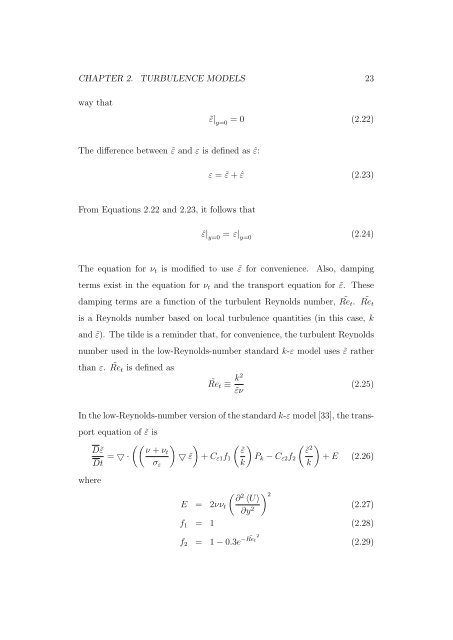The UMIST-N Near-Wall Treatment Applied to Periodic Channel Flow
The UMIST-N Near-Wall Treatment Applied to Periodic Channel Flow
The UMIST-N Near-Wall Treatment Applied to Periodic Channel Flow
Create successful ePaper yourself
Turn your PDF publications into a flip-book with our unique Google optimized e-Paper software.
CHAPTER 2. TURBULENCE MODELS 23<br />
way that<br />
<strong>The</strong> difference between ˜ε and ε is defined as ˆε:<br />
From Equations 2.22 and 2.23, it follows that<br />
˜ε| y=0 = 0 (2.22)<br />
ε = ˜ε + ˆε (2.23)<br />
ˆε| y=0 = ε| y=0<br />
(2.24)<br />
<strong>The</strong> equation for νt is modified <strong>to</strong> use ˜ε for convenience. Also, damping<br />
terms exist in the equation for νt and the transport equation for ˜ε. <strong>The</strong>se<br />
damping terms are a function of the turbulent Reynolds number, ˜<br />
Ret. ˜<br />
Ret<br />
is a Reynolds number based on local turbulence quantities (in this case, k<br />
and ˜ε). <strong>The</strong> tilde is a reminder that, for convenience, the turbulent Reynolds<br />
number used in the low-Reynolds-number standard k-ε model uses ˜ε rather<br />
than ε. ˜ Ret is defined as<br />
˜Ret ≡ k2<br />
˜εν<br />
(2.25)<br />
In the low-Reynolds-number version of the standard k-ε model [33], the trans-<br />
port equation of ˜ε is<br />
<br />
D˜ε ν + νt<br />
= ▽ ·<br />
Dt σε<br />
where<br />
<br />
▽ ˜ε + Cε1f1<br />
E = 2ννt<br />
<br />
˜ε<br />
Pk − Cε2f2<br />
k<br />
∂ 2 〈U〉<br />
∂y 2<br />
2<br />
2 ˜ε<br />
+ E (2.26)<br />
k<br />
(2.27)<br />
f1 = 1 (2.28)<br />
−Ret ˜<br />
f2 = 1 − 0.3e 2<br />
(2.29)















